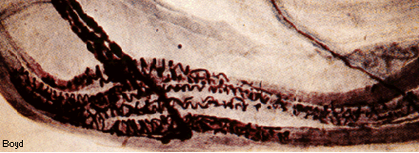From resting conditions:
Dynamic fusimotor stimulation causes local intrafusal contraction which stiffens the polar regions, but has little effect on the primary region.
Much of the external stretch is transmitted to the primary region which may extend by 15%.
When stretch is maintained the polar regions 'creep' and the primary endings unload slightly. This is the basis of slow mechanical adaptation.
Click on the Primary & Secondary Ending tab above to continue.
Stretch only results in the responses shown here for the primary and secondary endings (blue lines).
Simultaneous fusimotor stimulation at 75 Hz greatly increases the primary response to stretch, but has little effect on the secondary response (red lines).
Contraction of Bag1 fibres has little or no effect on the discharge of the secondary ending.
Dynamic bag fibres are responsible for the sensitivity of the primary ending to change in muscle length.
These diagrams show graphically the effects of stretch alone (blue line) and stretch with simultaneous fusimotor stimulation (red line) in the standard test format for investigating spindle afferent ending responses.
The Y-axis represents the instantaneous firing frequency of the afferent neuron, with a scale from 0 to 100 impulses per sec. The Ia neuron responses are on the left, the group II neuron responses on the right. The ‘length’ trace shows when the stretch was applied; up = stretch. The fusimotor neuron in this case is the gamma dynamic (γd) type and the red dotted line shows the period when it was turned on.
Taking the primary ending as an example:
- initially there is only a very low firing rate from this afferent ending
- stretch alone produces an instantaneous rise in firing rate to about 40/s which increases a bit more during the ramp phase of the stretch, firing rate then falls back to about 40/s during the ‘hold’ phase of the stretch, ceases firing altogether during the release phase (as the muscle length decreases), and finally recovers to a low rate once the release has finished
- stimulating the γd alone provokes a small rise in the firing rate
- combining γd stimulation with the ramp stretch now provokes much larger responses: an instantaneous rise in firing rate to about 60/s, followed by a further rise to about 140/s as the stretch continues
- as soon as the change in length stops, the firing rate falls to close to 100/s, and then during the ‘hold’period of the stretch it falls back to about 60/s
- during the ‘release’ phase, there is a further rapid fall in firing, then a ‘wobble’ as the release phase stops, and finally recovery to the initial low firing rate
Select another item from the menu on left to continue.


